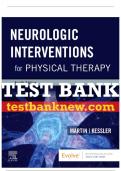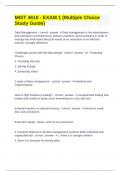.
Test Bank For Neurologic Interventions For Physical Therapy, 4th - 2021 All Chapters - 1223
9780323661751
1. A patient is brought to the ER following a motor vehicle accident in which he sustained head trauma.
Preliminary assessment reveals a vision deficit in the patients left eye. The nurse should associate this
abnormal finding with trauma to which of the following cerebral lobes?
A) Temporal
B) Occipital
C) Parietal
D) Frontal
Ans: B
Feedback:
The posterior lobe of the cerebral hemisphere is responsible for visual interpretation. The temporal lobe
contains the auditory receptive areas. The parietal lobe contains the primary sensory cortex, and is
essential to an individuals awareness of the body in space, as well as orientation in space and spatial
relations. The frontal lobe functions in concentration, abstract thought, information storage or memory,
and motor function.
2. A patient scheduled for magnetic resonance imaging (MRI) has arrived at the radiology department. The
nurse who prepares the patient for the MRI should prioritize which of the following actions?
A) Withholding stimulants 24 to 48 hours prior to exam
B) Removing all metal-containing objects
C) Instructing the patient to void prior to the MRI
D) Initiating an IV line for administration of contrast
Ans: B
Feedback:
Patient preparation for an MRI consists of removing all metal-containing objects prior to the
examination. Withholding stimulants would not affect an MRI; this relates to an electroencephalography
(EEG). Instructing the patient to void is patient preparation for a lumbar puncture. Initiating an IV line
for administration of contrast would be done if the patient was having a CT scan with contrast.
,Test Bank For Neurologic Interventions For Physical Therapy, 4th - 2021 All Chapters - 1224
9780323661751
3. A gerontologic nurse planning the neurologic assessment of an older adult is considering normal, age-
related changes. Of what phenomenon should the nurse be aware?
A) Hyperactive deep tendon reflexes
B) Reduction in cerebral blood flow
C) Increased cerebral metabolism
D) Hypersensitivity to painful stimuli
Ans: B
Feedback:
Reduction in cerebral blood flow (CBF) is a change that occurs in the normal aging process. Deep
tendon reflexes can be decreased or, in some cases, absent. Cerebral metabolism decreases as the patient
advances in age. Reaction to painful stimuli may be decreased with age. Because pain is an important
warning signal, caution must be used when hot or cold packs are used.
4. The nurse has admitted a new patient to the unit. One of the patients admitting orders is for an
adrenergic medication. The nurse knows that this medication will have what effect on the circulatory
system?
A) Thin, watery saliva
B) Increased heart rate
C) Decreased BP
D) Constricted bronchioles
Ans: B
Feedback:
The term adrenergic refers to the sympathetic nervous system. Sympathetic effects include an increased
rate and force of the heartbeat. Cholinergic effects, which correspond to the parasympathetic division of
the autonomic nervous system, include thin, watery saliva, decreased rate and force of heartbeat, and
decreased BP.
5. A nurse is assessing reflexes in a patient with hyperactive reflexes. When the patients foot is abruptly
dorsiflexed, it continues to beat two to three times before settling into a resting position. How would the
nurse document this finding?
A) Rigidity
,Test Bank For Neurologic Interventions For Physical Therapy, 4th - 2021 All Chapters - 1225
9780323661751
B) Flaccidity
C) Clonus
D) Ataxia
Ans: C
Feedback:
When reflexes are very hyperactive, a phenomenon called clonus may be elicited. If the foot is abruptly
dorsiflexed, it may continue to beat two to three times before it settles into a position of rest. Rigidity is
an increase in muscle tone at rest characterized by increased resistance to passive stretch. Flaccidity is
lack of muscle tone. Ataxia is the inability to coordinate muscle movements, resulting in difficulty
walking, talking, and performing self-care activities.
6. The nurse is doing an initial assessment on a patient newly admitted to the unit with a diagnosis of
cerebrovascular accident (CVA). The patient has difficulty copying a figure that the nurse has drawn and
is diagnosed with visual-receptive aphasia. What brain region is primarily involved in this deficit?
A) Temporal lobe
B) Parietal-occipital area
C) Inferior posterior frontal areas
D) Posterior frontal area
Ans: B
Feedback:
Difficulty copying a figure that the nurse has drawn would be considered visual-receptive aphasia,
which involves the parietal-occipital area. Expressive aphasia, the inability to express oneself, is often
associated with damage to the frontal area. Receptive aphasia, the inability to understand what someone
else is saying, is often associated with damage to the temporal lobe area.
7. What term is used to describe the fibrous connective tissue that hugs the brain closely and extends into
every fold of the brains surface?
A) Dura mater
B) Arachnoid
, Test Bank For Neurologic Interventions For Physical Therapy, 4th - 2021 All Chapters - 1226
9780323661751
C) Fascia
D) Pia mater
Ans: D
Feedback:
The term meninges describes the fibrous connective tissue that covers the brain and spinal cord. The
meninges have three layers, the dura mater, arachnoid, and pia mater. The pia mater is the innermost
membrane that hugs the brain closely and extends into every fold of the brains surface. The dura mater,
the outermost layer, covers the brain and spinal cord. The arachnoid, the middle membrane, is
responsible for the production of cerebrospinal fluid.
8. The nurse is caring for a patient with an upper motor neuron lesion. What clinical manifestations should
the nurse anticipate when planning the patients neurologic assessment?
A) Decreased muscle tone
B) Flaccid paralysis
C) Loss of voluntary control of movement
D) Slow reflexes
Ans: C
Feedback:
Upper motor neuron lesions do not cause muscle atrophy, flaccid paralysis, or slow reflexes. However,
upper motor neuron lesions normally cause loss of voluntary control.
9. The nurse is admitting a patient to the unit who is diagnosed with a lower motor neuron lesion. What
entry in the patients electronic record is most consistent with this diagnosis?
A) Patient exhibits increased muscle tone.
B) Patient demonstrates normal muscle structure with no evidence of atrophy.
C) Patient demonstrates hyperactive deep tendon reflexes.
D) Patient demonstrates an absence of deep tendon reflexes.
Ans: D





